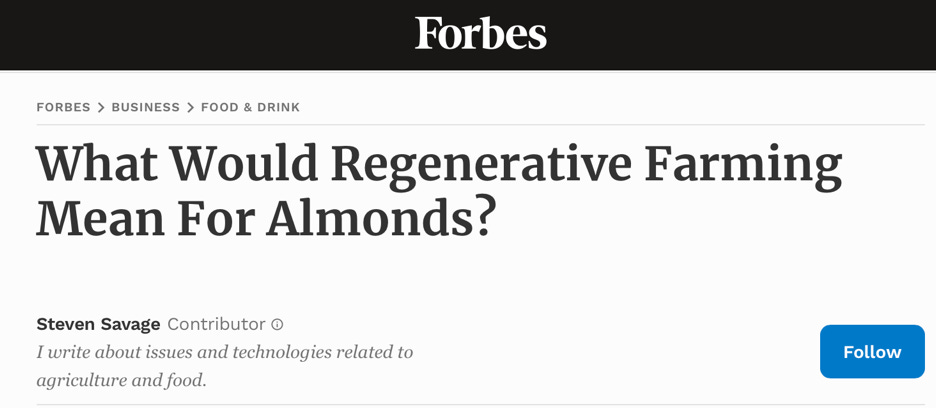Where are the regenerative almonds?
2-min read
The nice thing about this newsletter is I can say what I want. I don’t work for anyone here.
Last year I predicted regenerative almond farming will go one of two ways – small and exclusive, or greenwashed and ubiquitous.
While California legislators try to figure out what regenerative means, news on regenerative almond farming keeps coming.
I use almonds to explore how the industries of agriculture and consumer interact in the market, not only because it’s something I know a lot about, but because almonds are California’s top agricultural export and America’s favorite nut.
Almonds are a big industry
More context on how big and important the almond industry is:
· Covers 1.6m acres in California
· Contributes >$9 billion to the state’s economy
A lot of CPG products are built on almonds, and brands want to make consumers feel that’s OK. They do this through sustainability claims, like regenerative. The regenerative practices highlighted in the Forbes piece cost farmers more to implement, therefore the nuts will be more expensive.
Brands will have to pay more
Will brands be able to pass these costs on to consumers? That’s where things get a little tricky. A recent study shows that most consumers are not willing to pay more for regenerative agriculture.
Which begs the question, for almonds, what would regenerative farming mean?
Here’s what a regenerative almond orchard looks like (courtesy Burroughs Family Farms)
You can’t talk about regenerative almond farming without talking about water. And on this topic, almonds are in the news again.
Water is scarce
Remember that regenerative is primarily about soil health, which requires water. For permanent crops like almonds, you need to irrigate the entire orchard floor so cover crops germinate and build up that organic matter in the soil. The premise is, once you get the soil right, water retention and absorption improve, so you need less water and less inputs (fertilizer and amendments) throughout the season.
Water is expensive
I must point out that Mr. Kristof in this The New York Times opinion piece lost all credibility in my eyes when he wrote in the comments,
“if water prices rose to reflect its value and scarcity, farmers would make their own decisions and would use less water. Maybe they would still grow almonds -- but they would practice drip irrigation rather than flood irrigation. They would line irrigation ditches so as to lose less water.”
OK hold on Mr. Kristof. The facts about drip irrigation are:
· >80% of the industry has gone to drip irrigation because water is expensive and sustainability best practices have taught farmers this is the best way to conserve water
And the facts about lining ditches (canals):
· Even if you own the canal, you can’t line it when it’s going through someone else’s land – they have the rights to the seepage to recharge their groundwater
Lastly, groundwater recharge is a key strategy by the state of California, which brings me to the final point about flood irrigation:
· Flood irrigation is only available to orchards that have access to surface water. Timed correctly, those orchards can germinate cover crops, which is a regenerative practice.
Let’s play that through:
· Land IQ has found that 675,000 almond acres have access to surplus surface water
· But there are 1.6 million acres of almonds
· That means 60% of almond orchards cannot practice the most basic tenant of regenerative farming
· And for the 40% that have water access, they still have to pay for the cost and implementation of cover cropping
What about micro-sprinklers?
(This is getting in the weeds a little bit – no pun intended). Micro sprinklers only water along the berm. So, does this count?
Regenerative: another value tier
The jury is still out on what the state of California will deem as a definition for regenerative. If it involves building soil organic matter, it will cost farmers more. If most consumers won’t pay more for regenerative, but some will – then we are headed for another value tier like organic, which in my prediction, will be a premium play for a niche audience.
All my best,
Jennifer









